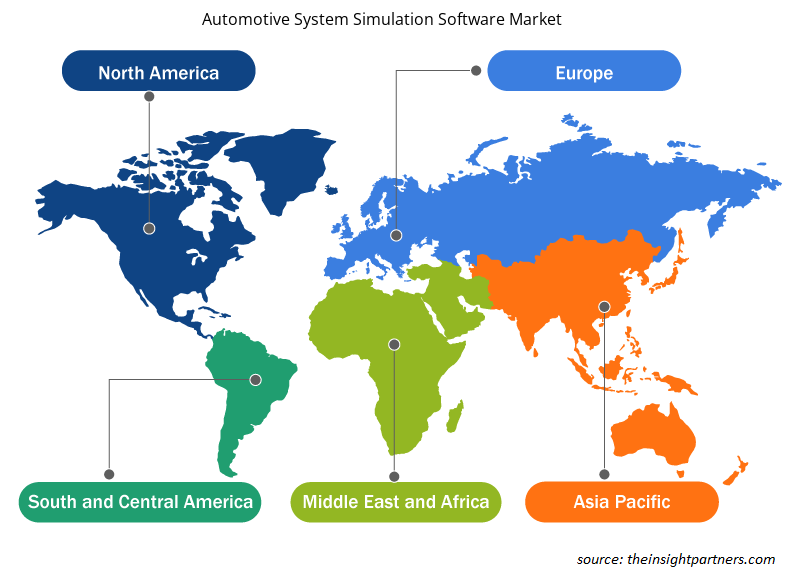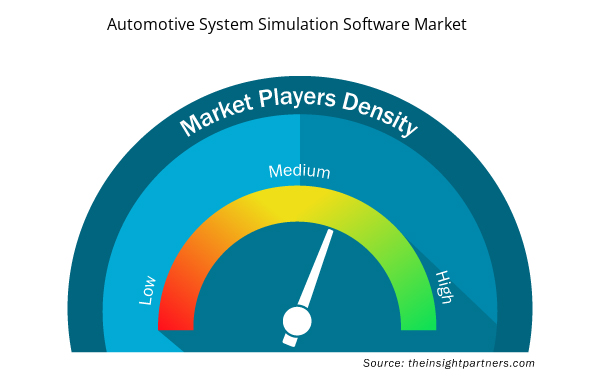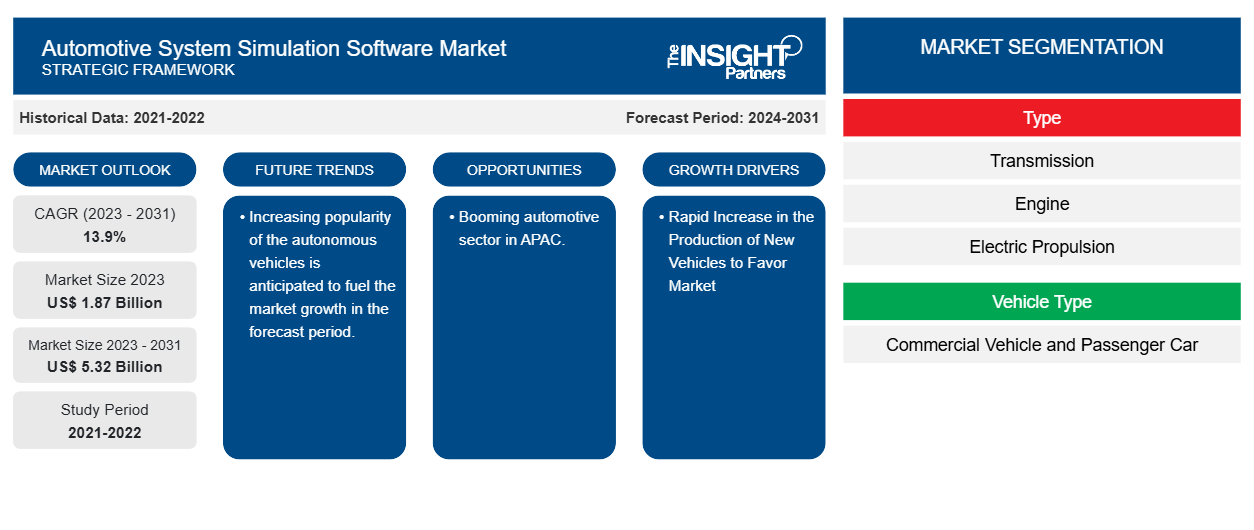自動車システムシミュレーションソフトウェアの市場規模は、2023年の18億7,000万米ドルから2031年には53億2,000万米ドルに達すると予測されています。市場は2023年から2031年の間に13.9%のCAGRを記録すると予想されています。車両機能のアップグレードとE/Eコンポーネント数の増加、電気自動車の生産と販売の増加は、市場の主要なトレンドと推進要因であり続けると思われます。
自動車システムシミュレーションソフトウェア市場分析
自動車システム シミュレーション ソフトウェア市場の需要は、新車生産の急増に伴い増加すると予想されています。OEM は、従来のプロトタイピング手法を自動車システム シミュレーションに移行して、新しいモデルを開発し、既存のモデルを改良しており、これが自動車システム シミュレーション ソフトウェア市場の活性化につながっています。
自動車システムシミュレーションソフトウェア市場の概要
自動車システム シミュレーション ソフトウェア (ASM) は、必要に応じて統合できる自動車アプリケーション用のシミュレーション モデルで構成されるツール スイートです。モデルは、燃焼エンジンや電気モーターなどの個々のコンポーネントから、車両ダイナミクス システム、複雑な仮想交通シナリオまで、幅広いシミュレーションをサポートします。モデルは、グラフィカル ユーザー インターフェイスの ModelDesk を使用して、簡単かつ直感的に操作できます。
要件に合わせてレポートをカスタマイズする
このレポートの一部、国レベルの分析、Excelデータパックなど、あらゆるレポートを無料でカスタマイズできます。また、スタートアップや大学向けのお得なオファーや割引もご利用いただけます。
- このレポートの主要な市場動向を入手してください。この無料サンプルには、市場動向から見積もりや予測に至るまでのデータ分析が含まれます。
自動車システムシミュレーションソフトウェア市場の推進要因と機会
新車生産の急増が市場を有利に
新車生産の急増が、自動車システムシミュレーションソフトウェア市場の成長を牽引しています。新車生産が増加するにつれて、自動車システムシミュレーションソフトウェアの需要も増加しています。たとえば、欧州自動車製造者協会(ACEA)によると、2022年には世界中で8,540万台の自動車が生産され、2021年と比較して5.7%増加しました。したがって、新車生産の増加は、自動車システムシミュレーションソフトウェア市場の成長を牽引する可能性があります。
アジア太平洋地域で急成長する自動車部門。
アジア太平洋地域の自動車産業はここ数年で活況を呈しています。急速な都市化、経済の繁栄、人口増加によって成長が促進され、アジア諸国では人や物資の移動ニーズが高まっています。さらに、自動車は時とともに近代化が進んでいます。さらに、この地域の KIA、Nio などの多くの企業が製品開発に注力しています。
自動車システムシミュレーションソフトウェア市場レポートセグメンテーション分析
自動車システムシミュレーションソフトウェア市場分析の導出に貢献した主要なセグメントは、タイプ、車両タイプ、および推進タイプです。
- 自動車システムシミュレーションソフトウェア市場は、タイプ別にトランスミッション、エンジン、電気推進、燃料電池、ドライブライン、シャーシ、その他に分類されます。トランスミッションセグメントは、予測期間中に最大のシェアを占めると予想されます。
- 車両タイプに基づいて、自動車システムシミュレーションソフトウェア市場は商用車と乗用車に分かれています。予測期間中、商用車セグメントが最大のシェアを占めると予想されます。
- 推進タイプに基づいて、自動車システムシミュレーションソフトウェア市場はICEと電気に分かれています。ICEセグメントは予測期間中に最大のシェアを占めると予想されます。
自動車システムシミュレーションソフトウェアの地域別市場シェア分析
自動車システムシミュレーションソフトウェア市場レポートの地理的範囲は、主に北米、アジア太平洋、ヨーロッパ、中東およびアフリカ、南米および中米の 5 つの地域に分かれています。
APAC が市場を支配しています。この地域には、現代の技術進歩に重点を置くメーカーが数多くあります。また、この地域は中国、日本、インドなどの新興経済国で構成されています。これらの国には重要な自動車産業があります。さらに、都市化と工業化により、大量の車両生産の需要が増加しており、それがこの地域の自動車システム シミュレーション ソフトウェア市場を活性化させています。
自動車システムシミュレーションソフトウェア市場の地域別分析
予測期間を通じて自動車システム シミュレーション ソフトウェア市場に影響を与える地域的な傾向と要因は、Insight Partners のアナリストによって徹底的に説明されています。このセクションでは、北米、ヨーロッパ、アジア太平洋、中東およびアフリカ、南米および中米にわたる自動車システム シミュレーション ソフトウェア市場のセグメントと地理についても説明します。

- 自動車システムシミュレーションソフトウェア市場の地域別データを入手
自動車システムシミュレーションソフトウェア市場レポートの範囲
| レポート属性 | 詳細 |
|---|---|
| 2023年の市場規模 | 18億7千万米ドル |
| 2031年までの市場規模 | 53.2億米ドル |
| 世界のCAGR(2023年~2031年) | 13.9% |
| 履歴データ | 2021-2022 |
| 予測期間 | 2024-2031 |
| 対象セグメント | タイプ別
|
| 対象地域と国 | 北米
|
| 市場リーダーと主要企業プロフィール |
|
自動車システムシミュレーションソフトウェア市場のプレーヤー密度:ビジネスダイナミクスへの影響を理解する
自動車システム シミュレーション ソフトウェア市場は、消費者の嗜好の変化、技術の進歩、製品の利点に対する認識の高まりなどの要因により、エンド ユーザーの需要が高まり、急速に成長しています。需要が高まるにつれて、企業は提供内容を拡大し、消費者のニーズを満たすために革新し、新たなトレンドを活用し、市場の成長をさらに促進しています。
市場プレーヤー密度とは、特定の市場または業界内で活動している企業または会社の分布を指します。これは、特定の市場スペースに、その市場規模または総市場価値に対してどれだけの競合相手 (市場プレーヤー) が存在するかを示します。
自動車システムシミュレーションソフトウェア市場で事業を展開している主要企業は次のとおりです。
- ESIグループ
- ANSYS, Inc
- ヘキサゴンAB
- dSPACE株式会社
- シーメンス
- モデロン
免責事項:上記の企業は、特定の順序でランク付けされていません。

- 自動車システムシミュレーションソフトウェア市場のトップキープレーヤーの概要を入手
自動車システムシミュレーションソフトウェア市場のニュースと最近の動向
自動車システム シミュレーション ソフトウェア市場は、主要な企業出版物、協会データ、データベースなどの一次調査と二次調査後の定性的および定量的データを収集することによって評価されます。自動車システム シミュレーション ソフトウェア市場におけるいくつかの開発を以下に示します。
- 計算知能の世界的リーダーである Altair は、航空宇宙および防衛分野で大きな実績を持ち、海洋、エネルギー、ターボ機械、自動車アプリケーションでも存在感を高めている計算流体力学 (CFD) ソフトウェアを提供する FlightStream のメーカーである Research in Flight を買収したことを発表しました。FlightStream は、高忠実度の CFD シミュレーションとエンジニアや設計者のニーズとの間のギャップを埋める、ユーザーフレンドリーでありながら強力なフロー ソルバーです。(出典: Altair、企業 Web サイト、2024 年 5 月)
- ローデ・シュワルツは、仮想テストドライビングのパイオニアである IPG Automotive と提携し、自動車レーダーのハードウェア・イン・ザ・ループ (HIL) 統合テストを再定義し、自動運転 (AD) テストを試験場から開発ラボに移行することでコストを削減しました。IPG Automotive の CarMaker シミュレーションソフトウェアと R&S AREG800A レーダーオブジェクトシミュレーター、および R&S QAT100 アドバンストアンテナアレイを組み合わせることで、自動車メーカーは、Euro NCAP で定義されているような ADAS/AD シナリオを、制御された安全で時間効率が良く、コストを削減しながらシミュレートできるようになります。(出典: ローデ・シュワルツの会社ウェブサイト、2024 年 4 月)
自動車システムシミュレーションソフトウェア市場レポートの対象範囲と成果物
「自動車システムシミュレーションソフトウェア市場の規模と予測(2021〜2031年)」レポートでは、以下の分野をカバーする市場の詳細な分析を提供しています。
- 対象範囲に含まれるすべての主要市場セグメントについて、世界、地域、国レベルでの自動車システム シミュレーション ソフトウェア市場の規模と予測。
- 自動車システム シミュレーション ソフトウェア市場の動向、および推進要因、制約、主要な機会などの市場動向。
- 詳細なPEST/ポーターの5つの力とSWOT分析
- 主要な市場動向、世界および地域の枠組み、主要プレーヤー、規制、最近の市場動向を網羅した自動車システム シミュレーション ソフトウェア市場分析。
- 市場集中、ヒートマップ分析、主要プレーヤー、自動車システム シミュレーション ソフトウェア市場の最近の動向を網羅した業界の状況と競争分析。
- 詳細な企業プロフィール。
- 過去2年間の分析、基準年、CAGRによる予測(7年間)
- PEST分析とSWOT分析
- 市場規模価値/数量 - 世界、地域、国
- 業界と競争環境
- Excel データセット



Report Coverage
Revenue forecast, Company Analysis, Industry landscape, Growth factors, and Trends

Segment Covered
This text is related
to segments covered.

Regional Scope
North America, Europe, Asia Pacific, Middle East & Africa, South & Central America

Country Scope
This text is related
to country scope.
よくある質問
The expected CAGR of the bucket elevator market is 13.9%.
The automotive system simulation software market is anticipated to reach US$ 5.23 billion by 2031.
The key players in the automotive system simulation software market are ESI Group, ANSYS, Inc, Hexagon AB, dSPACE GmbH, Siemens, Modelon, IPG Automotive GmbH, Realtime Technologies, Gamma Technologies, LLC, SimScale GmbH.
The increasing popularity of autonomous vehicles is anticipated to fuel market growth in the forecast period.
The upgrading of vehicle function and increase in the number of E/E components, growing production and sales of electric vehicles are likely to remain key trends and drivers in the market.
APAC dominated the automotive system simulation software market in 2023.
Trends and growth analysis reports related to Technology, Media and Telecommunications : READ MORE..
The Insight Partners performs research in 4 major stages: Data Collection & Secondary Research, Primary Research, Data Analysis and Data Triangulation & Final Review.
- Data Collection and Secondary Research:
As a market research and consulting firm operating from a decade, we have published and advised several client across the globe. First step for any study will start with an assessment of currently available data and insights from existing reports. Further, historical and current market information is collected from Investor Presentations, Annual Reports, SEC Filings, etc., and other information related to company’s performance and market positioning are gathered from Paid Databases (Factiva, Hoovers, and Reuters) and various other publications available in public domain.
Several associations trade associates, technical forums, institutes, societies and organization are accessed to gain technical as well as market related insights through their publications such as research papers, blogs and press releases related to the studies are referred to get cues about the market. Further, white papers, journals, magazines, and other news articles published in last 3 years are scrutinized and analyzed to understand the current market trends.
- Primary Research:
The primarily interview analysis comprise of data obtained from industry participants interview and answers to survey questions gathered by in-house primary team.
For primary research, interviews are conducted with industry experts/CEOs/Marketing Managers/VPs/Subject Matter Experts from both demand and supply side to get a 360-degree view of the market. The primary team conducts several interviews based on the complexity of the markets to understand the various market trends and dynamics which makes research more credible and precise.
A typical research interview fulfils the following functions:
- Provides first-hand information on the market size, market trends, growth trends, competitive landscape, and outlook
- Validates and strengthens in-house secondary research findings
- Develops the analysis team’s expertise and market understanding
Primary research involves email interactions and telephone interviews for each market, category, segment, and sub-segment across geographies. The participants who typically take part in such a process include, but are not limited to:
- Industry participants: VPs, business development managers, market intelligence managers and national sales managers
- Outside experts: Valuation experts, research analysts and key opinion leaders specializing in the electronics and semiconductor industry.
Below is the breakup of our primary respondents by company, designation, and region:

Once we receive the confirmation from primary research sources or primary respondents, we finalize the base year market estimation and forecast the data as per the macroeconomic and microeconomic factors assessed during data collection.
- Data Analysis:
Once data is validated through both secondary as well as primary respondents, we finalize the market estimations by hypothesis formulation and factor analysis at regional and country level.
- Macro-Economic Factor Analysis:
We analyse macroeconomic indicators such the gross domestic product (GDP), increase in the demand for goods and services across industries, technological advancement, regional economic growth, governmental policies, the influence of COVID-19, PEST analysis, and other aspects. This analysis aids in setting benchmarks for various nations/regions and approximating market splits. Additionally, the general trend of the aforementioned components aid in determining the market's development possibilities.
- Country Level Data:
Various factors that are especially aligned to the country are taken into account to determine the market size for a certain area and country, including the presence of vendors, such as headquarters and offices, the country's GDP, demand patterns, and industry growth. To comprehend the market dynamics for the nation, a number of growth variables, inhibitors, application areas, and current market trends are researched. The aforementioned elements aid in determining the country's overall market's growth potential.
- Company Profile:
The “Table of Contents” is formulated by listing and analyzing more than 25 - 30 companies operating in the market ecosystem across geographies. However, we profile only 10 companies as a standard practice in our syndicate reports. These 10 companies comprise leading, emerging, and regional players. Nonetheless, our analysis is not restricted to the 10 listed companies, we also analyze other companies present in the market to develop a holistic view and understand the prevailing trends. The “Company Profiles” section in the report covers key facts, business description, products & services, financial information, SWOT analysis, and key developments. The financial information presented is extracted from the annual reports and official documents of the publicly listed companies. Upon collecting the information for the sections of respective companies, we verify them via various primary sources and then compile the data in respective company profiles. The company level information helps us in deriving the base number as well as in forecasting the market size.
- Developing Base Number:
Aggregation of sales statistics (2020-2022) and macro-economic factor, and other secondary and primary research insights are utilized to arrive at base number and related market shares for 2022. The data gaps are identified in this step and relevant market data is analyzed, collected from paid primary interviews or databases. On finalizing the base year market size, forecasts are developed on the basis of macro-economic, industry and market growth factors and company level analysis.
- Data Triangulation and Final Review:
The market findings and base year market size calculations are validated from supply as well as demand side. Demand side validations are based on macro-economic factor analysis and benchmarks for respective regions and countries. In case of supply side validations, revenues of major companies are estimated (in case not available) based on industry benchmark, approximate number of employees, product portfolio, and primary interviews revenues are gathered. Further revenue from target product/service segment is assessed to avoid overshooting of market statistics. In case of heavy deviations between supply and demand side values, all thes steps are repeated to achieve synchronization.
We follow an iterative model, wherein we share our research findings with Subject Matter Experts (SME’s) and Key Opinion Leaders (KOLs) until consensus view of the market is not formulated – this model negates any drastic deviation in the opinions of experts. Only validated and universally acceptable research findings are quoted in our reports.
We have important check points that we use to validate our research findings – which we call – data triangulation, where we validate the information, we generate from secondary sources with primary interviews and then we re-validate with our internal data bases and Subject matter experts. This comprehensive model enables us to deliver high quality, reliable data in shortest possible time.


 このレポートの無料サンプルを入手する
このレポートの無料サンプルを入手する